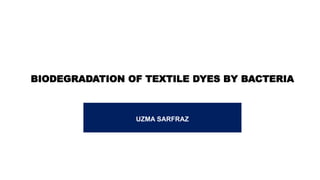
Biodegradation of textile dyes by bacteria
- 1. BIODEGRADATION OF TEXTILE DYES BY BACTERIA UZMA SARFRAZ
- 2. INTRODUCTION • The textile industry covers two-third of the gross dye stuff market. • During manufacturing and usage, approximately 10- 15% of the dye is lost directly to wastewater that finds its way into the environment. • The unused dyes and chemicals are discharge as dye effluent from various units. • Dyeing and finishing stages are major contributor • Bacteria are known to degrade and mineralize many reactive azo dyes faster.
- 3. Common Methodology For Bacterial Treatment Autoclaved mineral salt + textile waste effluent(L) in a bioreactor Add inoculum (ml) aseptically to make working solution (L) Stirring at room temperature with agitation speed (rpm) Fermentation (days) Calculation (Decolorization % = Din –Df Din *100) and Analysis of decolorization Filtration of solution through Whattman filter paper and centrifugation(minutes)
- 4. Bacterial Biodegradation Mechanism of Textile Dyes
- 5. CHARACTERIZATION TECHNIQUES Technique Main function UV-vis Spectrophotometry Dye decolorization GC-MS Identification of metabolites H NMR and SEM Morphology and for the structure of its molecule FTIR, HPLC and HPTLC analysis Confirmation of degradation of metabolites
- 6. Anaerobic Conditions • The enzyme azoreductase functions. • NADH and FADH are the reducing agents. • Oxygen possibly, inhibit the azo bond reduction activity, as aerobic respiration utilizes NADH, thus impeding the electron transfer from NADH to azo bonds. • Decolorization might be attributed to nonspecific extracellular reactions occurring between reduced compounds generated by the anaerobic biomass. • Decolorization is mediated by methanogens and acidogenic, as well as methanogenic bacteria. • It is a nonspecific process, depending on the carbon source and the dye structure. • Some bacteria taking part in the decolorization process could grow aerobically; however, decolorization is achieved only under anaerobic conditions.
- 7. Decolorization under Aerobic Conditions • Most bacteria that degrade dyes under aerobic conditions cannot utilize the dye as a carbon source and require an additional carbon source. • Very few bacteria are capable of growing on azo compounds as the sole carbon source. • These bacteria are able to cleave –N=N– bonds and utilize amines for their growth, for instance, Pigmentiphaga kullae K24 and Xenophilus azovorans KF 46. • Aerobic bacteria possess oxidoreductive enzymes and can break the dye molecules symmetrically or asymmetrically. • They could also bring about deamination, desulfonation, hydroxylation, etc. • Therefore, different dye structures can be broken down by anaerobic bacteria.
- 8. Decolorization under Anoxic Conditions • Anoxic conditions have less than 0.5 mg/L dissolved oxygen. • Operating conditions for these are similar to aerobic treatments. • NADPH carries more electrons for reduction. • Mixed bacterial populations of aerobic and facultative anaerobic have been shown to be useful in anoxic decolorization of various dyes. • This requires complex organic sources, which increases the cost.
- 9. Bacterial strains Dye and its concentration Conditions Decolorization (%) Time Bacillus sp. Blue 2B temperature 40°C and pH 7 60% 48 h Bacillus sp. Acid Orange 7 Temperature 370°C 73% 3 days Bacilluscereus (BN-7), Pseudomonas putida (BN-4), Pseudomonas fluorescence (BN-5)and Stenotrophomonas acidaminiphila (BN-3) AcidRed88 AcidRed119, AcidRed97, AcidBlue113, ReactiveRed120;(6 mgL-1 ) 7.0,35,100 rpm 78, 99, 94, 99,and 82. 24 hours Bacilluscereus (BN-7), Pseudomonas putida (BN-4), Pseudomonas fluorescence (BN-5)and Stenotrophomonas acidaminiphila (BN-3) AcidRed88 AcidRed119, AcidRed97, AcidBlue113, ReactiveRed120;(6 mgL-1 ) 7.0,35,100 rpm 78, 99, 94, 99,and 82. 24 hours Mixed bacterial consortium JW-2 ReactiveViolet5R;(100 mgL-1 6.5–8.5,25–37,static 100 36hrs Bacterial consortium SV Ranocid Fast Blue; (100 mgL-1) 7.0,37,static 100 24hrs Bacterial consortium DMC Direct Black 22 ;(100 mgL-1) 7.0,45,static >91 12hrs Bacterial consortium-GR (Proteus vulgaris and Miccrococcus glutamicus) Green HE4BD, mixture of 6 reactive dyes; (50 mgL-1each) 8.0,37,static 100 24hrs Penicillium sp. QQ and bacterial Sphingo monasxenophaga QYY Reactive Brilliant red X-3B and Acid Red B; (50 mgL-1) 3.0,30,static 87.8 72hrs
- 10. Bacterial Mediated Biodecolorization Of Wastewater Containing Mixed Reactive Dyes Using Jack-fruit Seed As Co-substrate • Decolorization of azo (reactive red-21 and reactive orange-16), and anthraquinone (reactive blue-19) dyes using jack-fruit seed powder as co- substrate. • Pseudomonas aeruginosa SVM16 • The effect of process parameters on decolorization was done by response surface methodology. • The results of decolorization of individual dye solution of reactive red-21, reactive orange-16, and reactive blue-19 is 97.7 %, 98.9 %, and 92.6 %. • The jack-fruit seed supplemented decolorization process reveals that treated water has shown lesser residual organic and color loading compared to treated water obtained from bio-decolourization process using yeast extract or other chemicals as co-substrate. • With FTIR, GC-MS, and 1 H NMR showed the complete mineralization of dye molecules. • Non-toxicity of treated water proves through positive germination test of Vigna radiata seeds.
- 11. UV-visible transmittance spectra of treated and untreated dye solution
- 12. H NMR spectra: (a) RO16 dye solution; (b) JFS solution; (c) untreated RO16 and JFS mixed solution; (d) treated mixed solution
- 13. Germinated green gram seed in treated water samples: (a) treated mixed RR21 and RO16 dye contaminated water sample; (b) treated mixed RR21, RO16 and RB19 dye contaminated dye water sample; (c) untreated textile wastewater; (d) treated textile wastewater.
- 14. Conclusion Bacterial decomposition of the wastewater is a viable option, as they do not produce large amounts of sludge, have no adverse effect on the environment, and are inexpensive Bacteria species (Gammaproteobacteria, Betaproteobacteria, and Bacilli Aspergillus niger, Pseudomonas fluorescence, Proteus morganii, Fusarium compacticum, Pseudomonas nigificans & Pseudomonas gellucidium ) have a significant potential for dye decolourization and degradation Mixed bacterial consortium utilization for textile dyes is a better option, that can effectively tolerate the stress conditions more than the single bacterial species.